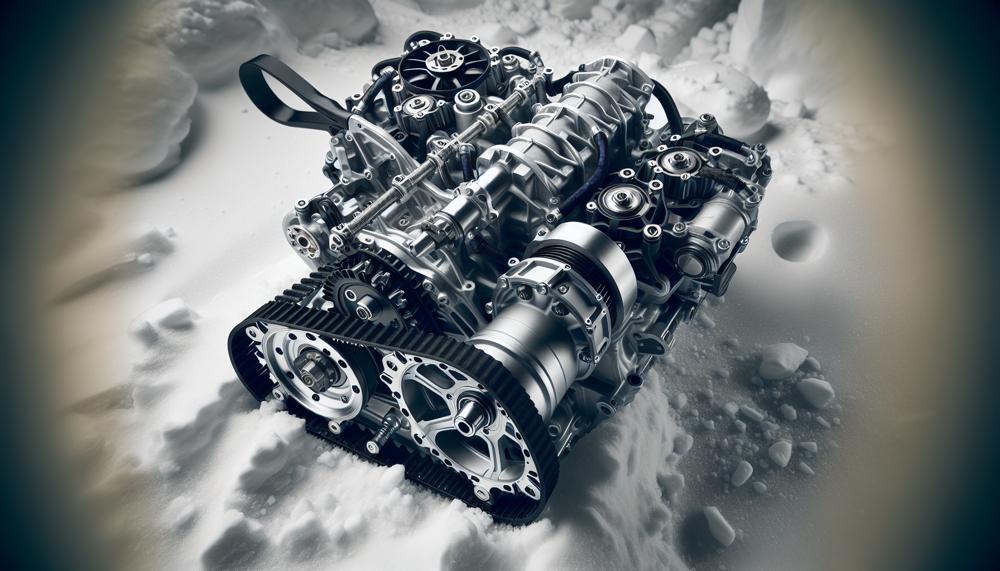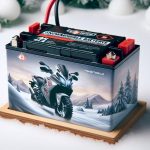As the winter chill sets in and the snow blankets the ground, outdoor enthusiasts eagerly anticipate their favorite winter activities. For some, it’s hitting the slopes for a day of skiing or snowboarding. But for others, the ultimate thrill comes from hopping on a snowmobile and racing through the snowy landscape.
Since their invention in the early 1900s, snowmobiles have been a popular mode of transportation for navigating through snowy terrain. But how exactly do these powerful machines operate? And can they function without two essential components – a can and belt?
In this blog post, we’ll delve into this intriguing question and take a closer look at the inner workings of a snowmobile’s engine. We’ll explore the importance of a can and belt in keeping your snowmobile running smoothly and discuss whether it’s possible to operate one without these crucial parts.
So bundle up (or should we say buckle up?) and get ready to learn all about the mechanics behind these exhilarating winter vehicles.
Here’s what we’ll cover:
- The fundamental components of a snowmobile engine
- The critical role of a can and belt in its operation
- Potential alternatives to using these components
- Expert insights on whether a snowmobile can truly function without them
Get ready to rev your engines as we dive deep into this fascinating topic.
Is It Safe to Run a Snowmobile Without a Belt?
Contents
- 1 Is It Safe to Run a Snowmobile Without a Belt?
- 2 When You Should Start Your Snowmobile Without a Belt
- 3 Why It Is Necessary To Have An Extra Snowmobile Drive Belt
- 4 Where To Store The Spare Belt
- 5 Belt Maintenance For A Longer Lifespan
- 5.1 Regular Inspections
- 5.2 Proper Lubrication and Chain Tension
- 5.3 Keep Up with Oil Changes
- 5.4 Maintain Your Coolant System
- 5.5 Suspension and Skid Frame Maintenance
- 5.6 Regular Filter Replacement
- 5.7 Inspect Carbides and Wear Guards
- 5.8 Check Your Exhaust System
- 5.9 Track Adjustment and Ski Alignment
- 5.10 Replace Your Belt When Necessary
- 5.11 1Utilize a Maintenance Checklist
- 6 What Is The Cost Of Snowmobile Belts?
- 7 Can A Snowmobile Start Or Run Without A Can?
- 8 Conclusion
Running a snowmobile without a belt can be extremely dangerous for both the rider and the machine. The following risks and dangers may arise from operating a snowmobile without a belt:
- Loss of power: The belt plays a vital role in transferring power from the engine to the track, allowing the snowmobile to move. Without a functioning belt, riders risk losing power, resulting in reduced speed and performance.
- Strain on other components: A missing or damaged belt can put strain on other parts of the snowmobile, such as the clutch and gears. This can lead to premature wear and tear on these parts, potentially resulting in expensive repairs or accidents if they fail during operation.
- Overheating: Belts are crucial in keeping the engine cool by circulating air through a cooling fan. Without this air circulation, the engine may overheat, causing significant damage and requiring costly repairs or rendering the snowmobile inoperable.
- Decreased fuel efficiency: A snowmobile without a functioning belt will consume more fuel as the engine works harder to compensate for the lack of power transfer. This adds extra costs for riders and contributes to environmental pollution.
- Compromised safety: Not having a functioning belt on a snowmobile can jeopardize the rider’s safety. Without proper stopping and maneuvering abilities, accidents and injuries can occur, especially in snowy terrain with uneven surfaces and obstacles.
It is crucial to have a functioning belt on a snowmobile for several reasons:
- Optimal performance: The belt is essential for the efficient operation of a snowmobile. Without it, riders risk losing power, speed, and control over their machine.
- Machine maintenance: The belt helps cool the engine, preventing it from overheating. Regularly checking and maintaining the belt can help prevent costly damages to other components of the snowmobile’s engine.
- Fuel efficiency: A functioning belt contributes to better fuel efficiency, reducing costs for riders and minimizing environmental impact.
- Rider safety: The belt plays a significant role in the safe operation of a snowmobile. It allows for proper stopping and maneuvering, ensuring the rider has full control over the machine and reducing the risk of accidents or injuries.
In summary, having a functioning belt on a snowmobile is crucial for optimal performance, machine maintenance, fuel efficiency, and rider safety.
Regularly checking and maintaining the belt is essential, and carrying a spare while riding is recommended to avoid unexpected damages in harsh conditions. Ignoring the importance of a snowmobile belt can lead to severe consequences, compromising both the rider’s safety and the machine’s longevity.
When You Should Start Your Snowmobile Without a Belt
When faced with an emergency situation, it is advised to never start your snowmobile without a belt. The snowmobile belt has a critical function of transferring power from the engine to the track, and starting the machine without one can result in significant damage. However, if you find yourself in a predicament where your belt has snapped, and you do not have a spare, there are some steps you can take to safely start your snowmobile without a belt.
- Inspect for external damages: Before attempting to start your snowmobile without a belt, carefully examine the machine for any external damages that may have caused the belt to snap. Look for any obstacles or debris that may have entered the clutch or track area.
- Disconnect the clutch: The clutch is responsible for engaging and disengaging the engine power to the track. By disconnecting it, you can prevent further damage to the machine while starting it without a belt.
- Utilize a tow rope: If you have a friend or another snowmobiler with you, use a durable tow rope to pull your snowmobile and get it started. This way, you can avoid putting unnecessary strain on the components and potentially causing more damage.
- Start the engine cautiously: Once the snowmobile is in motion, start the engine slowly to avoid any sudden jerks or jolts that can cause harm.
- Proceed with caution: Without a belt, there will be limited power and speed available. It is crucial to take it slow and avoid rough terrain until you can bring your snowmobile to a mechanic for proper repairs.
Remember, starting a snowmobile without a belt should always be used as a last resort and should not become a regular practice.
Always ensure that your snowmobile is well-maintained and carry a spare belt with you while riding to avoid any unforeseen damages on your journey.
Why It Is Necessary To Have An Extra Snowmobile Drive Belt
It is crucial to have an additional drive belt while snowmobiling for various reasons including safety, cost-saving, time-saving, and responsible riding. It enables riders to swiftly replace a broken belt, preventing potential hazards and expensive repairs.
Moreover, it saves time and frustration by avoiding delays in trips, while also demonstrating preparedness and responsibility as a rider.
As such, it is always recommended for snowmobilers to carry an extra drive belt with them while riding for a seamless and enjoyable experience.
| Reasons | Explanation |
|---|---|
| Safety | Having an extra drive belt ensures the safety of the rider in case of a breakdown in remote or isolated areas where assistance may not be readily available. This can be especially important in emergency situations where a quick replacement of the belt can prevent further harm. |
| Cost-saving | Replacing a broken belt with a spare one can prevent potential damage to other engine components, saving riders from expensive repairs. This not only saves money but also prevents any unexpected breakdowns that can lead to additional costs. |
| Time-saving | An extra drive belt allows riders to quickly replace a broken one and continue their journey without wasting time waiting for repairs or assistance. This is especially important in long-distance riding where time is of the essence. |
| Preparedness and responsibility | Carrying an extra drive belt shows that riders are responsible and take their safety seriously while also being prepared for unexpected situations. This demonstrates their commitment to safe riding and readiness for any potential risks. |
In addition to these benefits, having an extra drive belt also ensures that riders are equipped with the necessary tools to handle any potential setbacks while on their snowmobiling adventure. This not only adds to the overall safety and enjoyment of the trip but also allows for a stress-free experience.
Where To Store The Spare Belt
There are several potential ways to store a spare belt on a snowmobile, depending on individual preferences and the type of sled. These options include utilizing a designated storage compartment, keeping it in a backpack or saddlebag, or utilizing a specialized belt holder that is attached to the sled. It is crucial to ensure that the spare belt is conveniently accessible and shielded from any potential damage during the ride.
One option for storing a spare belt is to use a designated storage compartment. This is typically located somewhere on the snowmobile, such as under the seat or in the front portion of the sled. Some snowmobiles may come with built-in storage compartments specifically designed for holding spare belts. This option not only keeps the spare belt secure and protected but also ensures easy access in case of an emergency.
Another option is to carry the spare belt in a backpack or saddlebag while riding. This option may be preferred by riders who do not have a designated storage compartment on their sled. However, it is important to make sure that the backpack or saddlebag is securely fastened to the snowmobile to avoid any accidents or loss of the spare belt.
For those who prefer a more convenient and easily accessible option, using a specific belt holder attached to the sled may be ideal. This allows for quick and effortless access to the spare belt without having to stop and take off a backpack or saddlebag.
Additionally, this option helps protect the spare belt from any potential damage caused by debris or other external factors during the ride.
Belt Maintenance For A Longer Lifespan
Properly maintaining your snowmobile’s belt is crucial to ensure its longevity and peak performance on the trails. As one of the most important components of a snowmobile, the belt is responsible for transferring power from the engine to the track.
Here are some essential maintenance tips to keep in mind for a longer lifespan of your snowmobile’s belt.
Regular Inspections
Performing a thorough pre-ride inspection is highly recommended to check for any signs of wear, damage, or necessary repairs. This includes closely examining the belt for cracks, fraying, or any other visible damage.
If any issues are found, it is critical to address them before taking your snowmobile out for a ride.
Proper Lubrication and Chain Tension
Regularly lubricating the chaincase and ensuring proper chain tension is crucial for maintaining smooth operation and preventing premature wear on the belt.
Be sure to follow manufacturer recommendations for lubricants and tension settings.
Keep Up with Oil Changes
For 4-stroke engines, regularly changing the oil is essential to keep the engine running smoothly and prevent any potential damage to the belt.
In 2-stroke machines, it is crucial to frequently inspect the oil line to ensure proper lubrication.
Maintain Your Coolant System
Frequent inspections of the coolant system are crucial, especially for fan-cooled machines.
Be sure to check for any leaks or low levels of coolant, as this can cause overheating and potential damage to the belt.
Suspension and Skid Frame Maintenance
Greasing the suspension and skid frame regularly can prevent premature wear and damage to these important components, ultimately prolonging the life of your snowmobile’s belt.

Regular Filter Replacement
Following manufacturer recommendations for replacing filters such as fuel and air filters can help maintain optimal performance of your snowmobile’s engine, which in turn can extend the life of the belt.
Inspect Carbides and Wear Guards
Worn carbides or wear guards on the skis can cause damage to the belt and affect the snowmobile’s handling
Regularly inspecting and replacing these components when necessary is crucial for safety and performance.
Check Your Exhaust System
Inspecting the exhaust system for rust or holes is important to avoid loudness and decreased performance.
Any issues should be addressed immediately to prevent further damage to the belt.
Track Adjustment and Ski Alignment
Regularly adjusting the track tension and ensuring proper ski alignment can help prevent damage to internal components, including the belt.
Replace Your Belt When Necessary
It is recommended to inspect the belt for wear and tear before every ride.
If any signs of damage or excessive wear are found, it is crucial to replace the belt before riding again.
1Utilize a Maintenance Checklist
To ensure that all necessary maintenance tasks are done regularly, it is helpful to have a printed checklist for quick reference.
What Is The Cost Of Snowmobile Belts?
When it comes to snowmobile belts, the average cost can range from $50 to $200. However, there are also other expenses to consider, such as labor charges and the frequency of replacement, which can significantly impact the overall cost.
As a snowmobile owner, it’s crucial to take these factors into account and budget accordingly to ensure your snowmobile is performing at its best.
Snowmobile belts are an integral part of the machine, responsible for transferring power from the engine to the track. Without a properly functioning belt, your snowmobile’s performance and safety can be compromised. That’s why it’s crucial to understand the cost associated with these belts and invest in high-quality replacements when necessary.
The price of snowmobile belts can vary depending on several factors, including the make and model of your snowmobile, as well as the type of terrain you ride on.
Additionally, labor charges for installation can also add up, especially if you’re not replacing the belt yourself.
Another factor to consider is the frequency of replacement. While some belts may last multiple seasons, others may need to be replaced more often, especially with frequent use in harsh conditions. It’s essential to monitor your belt’s condition regularly and replace it when needed to avoid any potential breakdowns.
To ensure your snowmobile is running at optimal performance and for your own safety, it’s crucial to budget accordingly for snowmobile belts.
By considering all factors and investing in high-quality replacements when needed, you can prolong the life of your snowmobile and enjoy a smoother riding experience.
Can A Snowmobile Start Or Run Without A Can?
While a snowmobile may still start and run without a belt or can, it would significantly impact its performance. The belt is an essential component that transfers power from the engine to the track, allowing the snowmobile to move. Without a belt, the machine would have reduced speed, control, and acceleration, making it difficult and unsafe to ride.
Additionally, the lack of a belt can cause damage to other parts of the snowmobile, such as the clutching system, which can lead to costly repairs.
Factors such as temperature, riding conditions, and maintenance can affect a snowmobile’s performance without a belt or can.
In colder temperatures, the lack of a belt can cause overheating as the engine works harder to move the snowmobile.
Harsh riding conditions like deep snow or steep terrain can also put strain on the engine and other components without a functioning belt.
Regular inspection and maintenance of the belt are crucial in ensuring its proper functioning and avoiding any issues while riding.
To better understand the impact of not having a belt or can on a snowmobile’s performance, let us consider an example scenario:
TABLE:
| Riding Condition | Temperature | Belt/Can Functioning | Performance Impact |
| Deep Snow | -10°C (14°F) | Belt not functioning properly | Reduced speed and control, potential overheating and damage to other components. |
| Trail Riding | -5°C (23°F) | Belt fully functioning | Optimal performance and speed. |
| Steep Terrain | -15°C (5°F) | Belt missing | Unable to ride due to lack of power transfer, potential damage to clutching system and overheating. |
So, a snowmobile cannot function properly without a belt or can. It is an essential component that not only affects the machine’s speed and control but also prevents damage to other parts.
It is crucial to regularly inspect and maintain the belt and carry a spare while riding in harsh conditions to ensure a safe and enjoyable experience. Investing in high-quality replacements when needed can also save money in the long run by avoiding costly repairs.
Also Read: Can Snowmobiles on Pavement?
Conclusion
In conclusion, snowmobiling is an exhilarating winter activity that requires proper maintenance and care for optimal performance and safety. The can and belt are crucial components of a snowmobile’s engine, playing a critical role in its operation.
While it may be tempting to start a snowmobile without these components, it is not only unsafe but can also result in costly damages and compromised performance.
To ensure a safe and enjoyable experience while snowmobiling, it is imperative to have a functional belt on your machine at all times. Regularly inspecting and maintaining the belt, as well as carrying a spare while riding, can prevent unexpected breakdowns and expensive repairs.
Storing the spare belt in a designated compartment or using specialized holders attached to the sled are recommended options for easy access and protection.
Proper maintenance of the belt includes regular inspections, lubrication, oil changes, coolant system checks, suspension and skid frame upkeep, filter replacements, exhaust system evaluations, track adjustments, and ski alignment. It is also vital to replace the belt when necessary to avoid potential hazards.
With these tips in mind, you can prolong the lifespan of your snowmobile’s belt and enjoy endless adventures on the snowy trails.






